In this Article
- 1 Potted Herb Garden
- 2 Windowsill Herb Garden
- 3 Balcony Herb Garden
- 4 Rooftop Herb Garden
- 5 Vertical Herb Garden
- 6 Hanging Herb Garden
- 7 Self-Watering Mini Herb Garden
- 8 Raised Garden Beds
- 9 Greenhouse Herb Garden
- 10 Upcycled Herb Garden
- 11 Spiral Herb Garden
- 12 Bookshelf Herb Garden
- 13 Herbs as Fences and Borders
- 14 Herbs as Companion Plants
If you are tired of running to a market whenever you need fresh basil, rosemary, or cilantro, it might be time to plant your herb garden. Herbs are generally easy to grow and maintain — a perfect start if you have little or no experience in gardening. Furthermore, growing such a garden is a terrific way to explore your creativity, learn about new plants, and enjoy those you already like.
On the other hand, you might already have a lovely garden and wish to expand it, yet you don’t know how. No worries! Whether you are an absolute beginner or have conquered basics long ago, this article will provide numerous indoor and outdoor herb garden ideas and help you create a piece of heaven filled with fragrant and delicious greenery.
Potted Herb Garden
One of the easiest ways to start a garden is to plant herbs in pots. Pots are a handsome solution if you wish to start small. They allow you to control growing conditions. Another positive side is that you can keep them almost anywhere – indoors and out.
Clay and ceramic pots have decorative value. Planted with aromatic herbs like lavender, dill, chamomile, or rosemary, colourful pots with intricate designs may enhance your living space. You can also place larger ones near your favourite garden bench, and use them to decorate paths or distant backyard corners. Even a chipped pot can become a lovely rustic detail.
Aside from that, a specific type of soil and favourable growing conditions will make your potted garden flourish no matter what herbs you plant. However, if you are new to gardening, it’s best to stick to the basics, such as parsley, mint, chives, thyme, and basil.
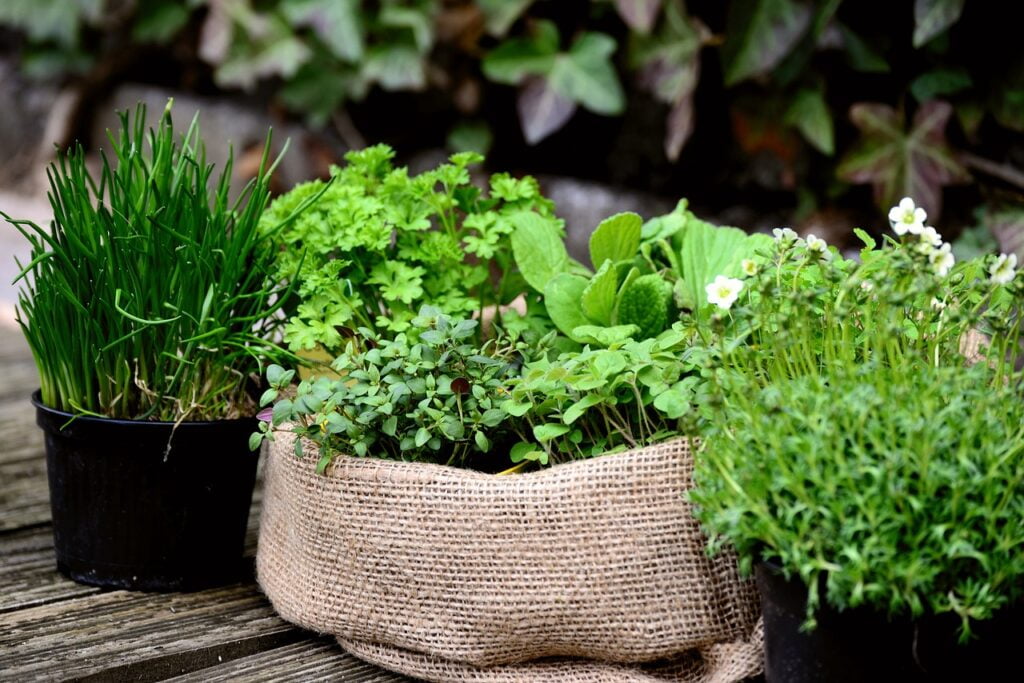
Windowsill Herb Garden
If you prefer having herbs at your fingertips whenever you need to spice up a meal, consider growing them on a windowsill. A bright kitchen window is a terrific location for this type of garden. However, such space can become quite humid during meal preparation, so make sure the window is away from the stove or plant herbs that can withstand high temperatures and humidity.
Windowsill is suitable for growing multiple herbs in small pots or containers. Some popular choices are coriander, chives, thyme, parsley, and mint. You can also try cultivating herbal microgreens. If you are planting herbs in separate containers, make sure each has at least one drainage hole and saucer.
In case you decide to group different herbs in one pot, avoid invasive species such as mint and lemon balm. These two are best kept in separate pots to prevent them from taking over the garden. Instead, try combining sage with chives and parsley or basil, oregano, and thyme.
Balcony Herb Garden
A rare few feelings can compare to drinking an afternoon tea on a balcony surrounded by the pungent smell of basil, mint, or sage. Cultivating an herb garden in an open-air space like that is rewarding. It takes just a little planning and basic gardening skills.
Now, before you begin collecting plants and seeds, always consider the outdoor conditions. If the balcony is shadowy, try finding a spot where plants can receive sufficient light. Most herbs prefer locations where they can get at least 6 hours of sunlight, yet some species do well even when light is limited. For instance, basil and oregano thrive in full sun, chamomile tolerates semi-shade, and parsley prefers shady spots.
A balcony garden is an ideal solution for herbs that don’t grow large. You can keep them in separate pots or all together in one large container, mount them on a wall or fence – planting options are almost limitless.
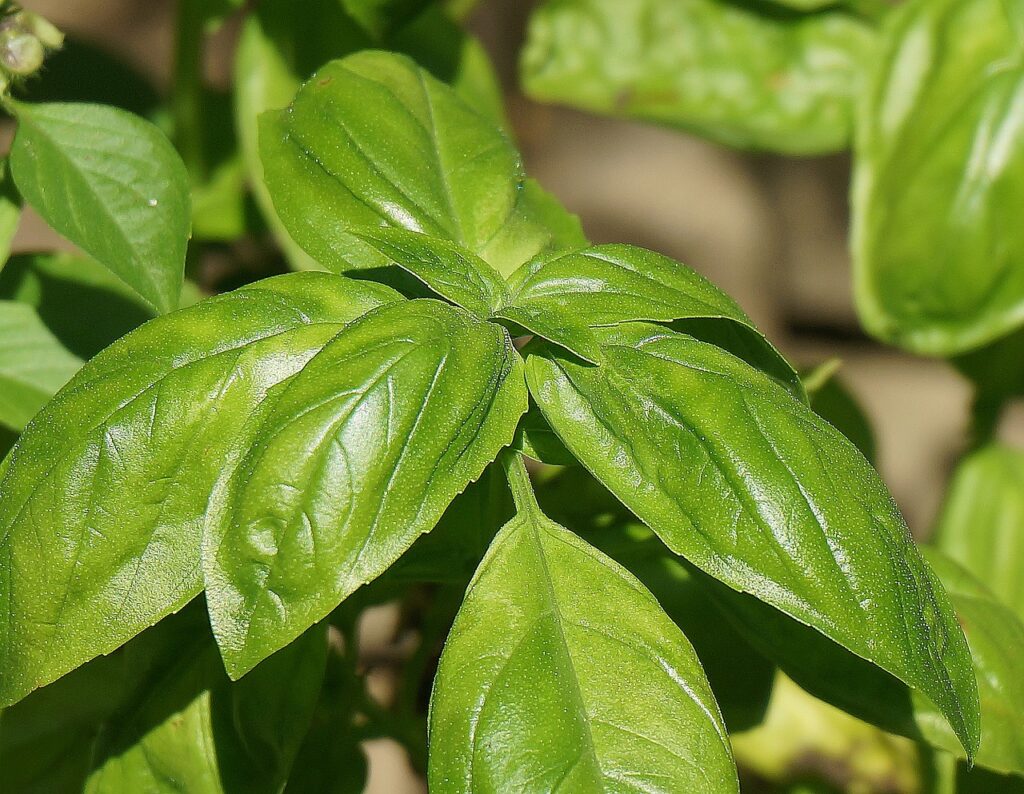
Rooftop Herb Garden
A rooftop garden became one of the popular gardening solutions in urban areas. So, if you live in a building with access to the roof, give it a try. It is a great way to use unused space and turn it into a place where you can relax surrounded by wonderful scents.
You can start by planting a few herbs in pots or containers. If you feel confident enough for something more complex, try building raised garden beds. However, that endeavour might take some time and effort, especially if you need to install an irrigation system.
Also, a roof garden is not suitable for all herbs. For instance, water mint, parsley, hyssop, or coriander are perfect for areas where it rains frequently. Of course, if you have a sunny roof, the best option is to plant herbs originating from warmer climates, such as basil, fennel, oregano, bay leaves, chives, and rosemary.
Vertical Herb Garden
If you wish to grow a large number of herbs in a limited space, consider starting a vertical garden. This gardening solution is suitable for both indoors and outdoors — you can install such gardens on walls, fences, or rooftops. You can make it using metal or wooden shelves, plastic or thin containers, old metal pipes and ropes, and sometimes a shoe organizer will do the trick. With features such as a self-irrigation system or UVB lights, it will practically grow itself.
Nonetheless, vertical gardens aren’t suitable for all herbs. So, to avoid unpleasant surprises, start by planting sage, basil, mint, oregano, thyme, rosemary, or lemon balm. Make sure to plant species that require less water at the top and those that thrive in damp conditions at the bottom of your vertical garden. Also, consider grouping them according to their origin. For example, Mediterranean herbs usually require more light and less watering, so you can place them atop the garden.

Hanging Herb Garden
Another practical solution for small spaces is a hanging herb garden. It requires a small effort when it comes to installation, yet it is a fun gardening solution. All you need are hooks or poles fixed on a wall and pots or containers suitable for hanging. Light clay pots with firm ropes, metal buckets with chains, wooden boxes, or hanging baskets of various shapes and designs will make an interesting addition to your kitchen, porch, or balcony.
Another positive side of growing herbs in such a hanging garden is the possibility of moving them around. You can keep it outside while the weather is favourable, move it inside once it gets cold, and have fresh herbs all year round.
Hanging pots and containers are suitable for growing nearly any herb. However, it’s always best to start with safe choices such as dill, parsley, marjoram, rosemary, lavender, chives, mint, basil, or oregano.
Self-Watering Mini Herb Garden
The most common mistake inexperienced gardeners make is to underwater or overwater the plants. Making a self-watering garden will help you resolve this issue. There are different ways to create this type of garden, and most of them include nothing more than a couple of kitchen supplies.
For instance, you can create a self-watering windowsill garden with a jar, a tea strainer that can fit into a jar (or a small pot with multiple drainage holes), and a piece of rope. Place a piece of rope in a tea strainer so the ends dangle over the edges and plant the selected herb. Fill the jar with water just enough so the ends of the rope can reach it, and place the tea strainer so it stays above it. The plant will get the necessary water through the rope, and all you’ll need is to refill the jar from time to time.
You can achieve a similar effect by using a plastic bottle and a piece of rope or fabric. And, if you prefer more elegant solutions, there are various self-watering pots and inserts you can buy in almost any shop that sells garden tools.
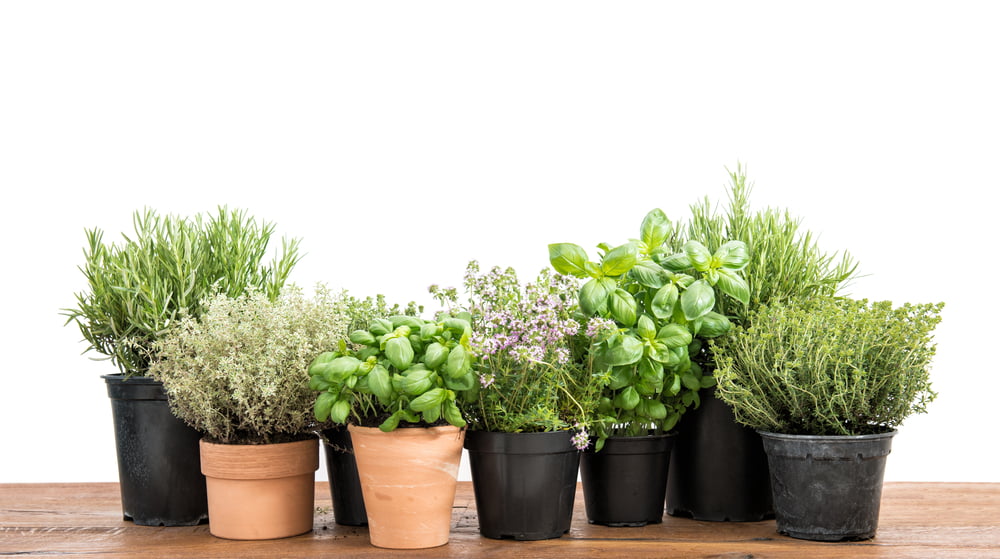
Raised Garden Beds
If you already have an outdoor herb garden that needs some expanding and refreshing, raised garden beds might be the solution you’ve been looking for. These box-like constructions made from wood, bricks, stone, or even concrete represent constrained planting areas that provide better drainage, accessibility, and overall control over your crops.
You can build raised beds on any surface — from grass to gravel, and they can come in any dimensions you need them to be. The size of the garden bed will depend on the number and type of plants you wish to cultivate. Another advantage of this gardening technique is that you can fill the beds with soil suitable for specific plants. For example, rosemary will thrive in loam, while bay prefers chalk.
Raised beds are suitable for cultivating all types of herbs. You can use them to grow different species separately or plant them all together and even make them companion plants to other crops.
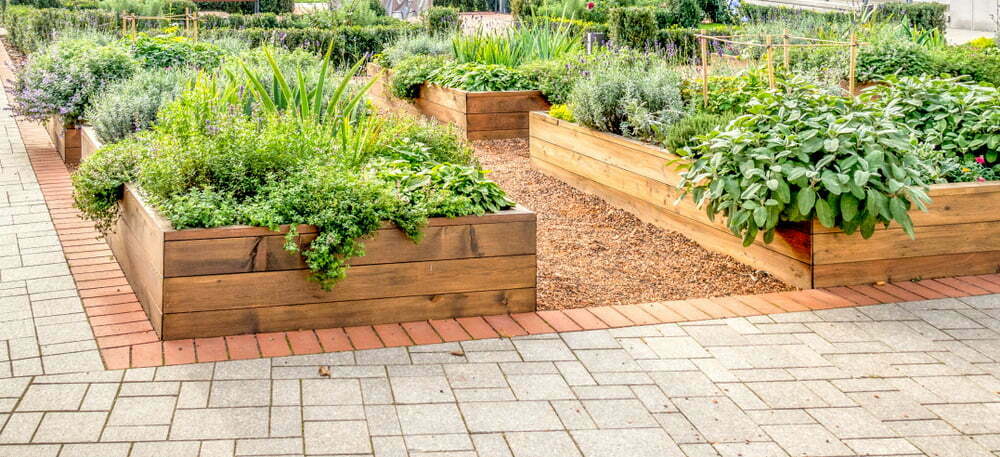
Greenhouse Herb Garden
Greenhouses are sources of fresh herbs and vegetables all year round. They can be used for mass production or personal needs. A traditional greenhouse is a shed-like construction covered with see-through plastic or glass. It is designed to regulate growing conditions such as temperature and humidity and is a perfect shelter for plants during autumn and winter.
There are many different types of greenhouses. So, before you decide whether to build one or not, ask yourself how much space can you spare for planting areas, what species you wish to grow, and for what purpose. If you have enough room in your backyard, try building a traditional greenhouse. However, if your space is limited and you are looking for a way to grow herbs indoors, there are some interesting portable greenhouse solutions you can either build yourself or purchase in specialised garden stores.
Greenhouses are suitable for growing all herbs — marjoram, sage, basil, rosemary, dill, lavender, chives, mint, parsley, and tarragon.
Upcycled Herb Garden
Garden upcycling has become quite popular in recent years and for good reasons. It is a great way to repurpose items that lost their use and save money on pots and containers. So, before you start throwing old things away, consider whether they could be used as a pot, plant stand, or a part of a wall for raised garden beds.
For instance, you can transform an old tea set into a lovely windowsill garden by drilling small holes at the bottom of each teacup or creating a sort of drainage system. Old ladders or dresser drawer can easily become vertical planters, while old paint canisters, tin cans, jars, and coolers can be pretty handsome pots. You can also use empty wine bottles as borders for garden beds or make a raised garden bed from an old wheelbarrow.
With proper care, any herb can thrive in the upcycled garden.
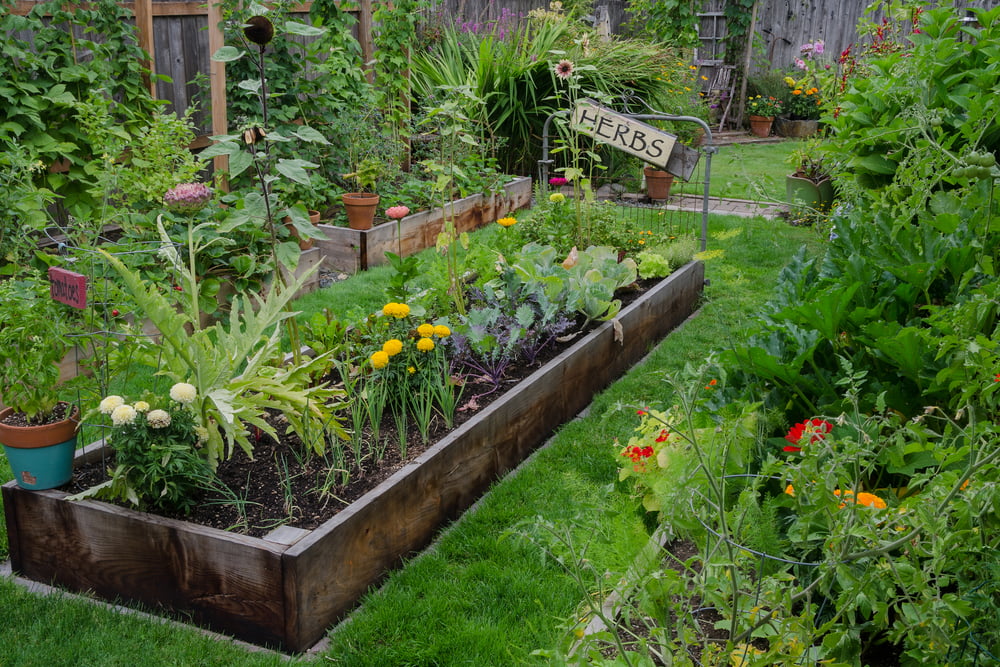
Spiral Herb Garden
When it comes to a garden design, the options are limitless. Although aesthetic gardening solutions are usually reserved for flowers and decorative plants, there is no reason why you shouldn’t try upgrading your herb garden. With some basic building skills and access to materials like stones, bricks, or pebbles, you can create a spiral herb garden that is both space-saving and visually appealing.
It is a small construction with a gradually elevated planting area in the shape of a spiral. All species of herbs can thrive in such a garden as long as you pay attention to their placement. Mediterranean herbs — rosemary, oregano, thyme, basil, sage, tarragon, fennel, dill, etc. — should be planted at the top of the construction or near it, where they will have better drainage and more sun exposure. Herbs like parsley, cilantro, mint, and lemon balm will do well in lower parts of construction as well.
Bookshelf Herb Garden
If your indoor garden can no longer fit on one shelf or windowsill, consider using a bookshelf. It can be an appealing design solution and yet another way to save space. Stacking pots on an old bookshelf is one of the most obvious options, but there is no reason not to get creative.
For instance, you could tilt shelves to ensure each herb has enough light exposure and add a small rod or strip to stop pots from sliding out. Additionally, you can drill holes big enough to fit each pot and fixate them to a shelf. You may place this construction on the balcony, rooftop, or yard.
If you have an open space between your kitchen and dining or living room, add a built-in bookshelf herb garden as a separator. It will not only transform the space, but you will also have a fresh at arm’s length.
To grow herbs this way, stick to the same principles you would apply in any vertical garden — if you cultivate plants that need more sun exposure, place them on the higher shelves (or ones that receive the most light).
Herbs as Fences and Borders
Most herbs grow in a shrub-like form, which makes them wonderful natural borders between garden beds and the lawn. It is a delicious, low-maintenance and practical way to edge garden.
Gardners use herbs to outline flower beds, where they also add an aesthetic value. These garden borders are one of the first things that attract the eye, and they usually include herbs with unusual foliage and beautiful blossoms. For example, chamomile is an excellent choice because you can combine it with various decorative plants. Rich aroma and lovely bloom make hyssop, rosemary, calendula, and chives good picks as well.
Aside from that, many herbs can edge pathways and patios or vegetable gardens. If you are looking for a way to decorate a sitting area or a path through your yard, lavender, dill, and fennel will do the trick. And, when it comes to vegetable gardens, you should always choose herbs that are good companion plants.
Herbs as Companion Plants
Companion planting is the best way to grow a healthy, delicious, and colourful garden. It is a gardening technique that revolves around planting different plants together to deter pests, attract pollinators, or simply separate species.
When it comes to a companion planting of herbs, there are numerous combinations to try out. You can either create a garden filled with only herbs or use them to help the growth of specific vegetables.
For instance, basil repels pests such as whiteflies and mosquitos and draws bees. It is a good match with tomato, peppers, asparagus, oregano, and parsley. Chives deter aphids and grow well with carrots, sunflowers, dill, marjoram, tarragon, and parsley. Mint repels flea beetles and cabbage moths, and it is a great companion for peas, tomatoes, cabbage, and oregano. However, the best option is to keep it in a pot near these plants since mint is known as a vigorous grower.
Aside from being great repellent, herbs can help other plants develop and improve their aroma. This is especially true when it comes to highly fragrant species such as oregano, lemon balm, or bay.
If the bees, butterflies, and other pollinators are rare guests in your garden, you should consider planting some highly aromatic herbs with attractive flowers. Hyssop, with its flower stalks covered with light purple blossom, is one of the most common picks. Lavender, chives, and bee balm also have flowers that appeal to small insects and birds, while fennel, sage, thyme and rosemary attract them with their scent.

